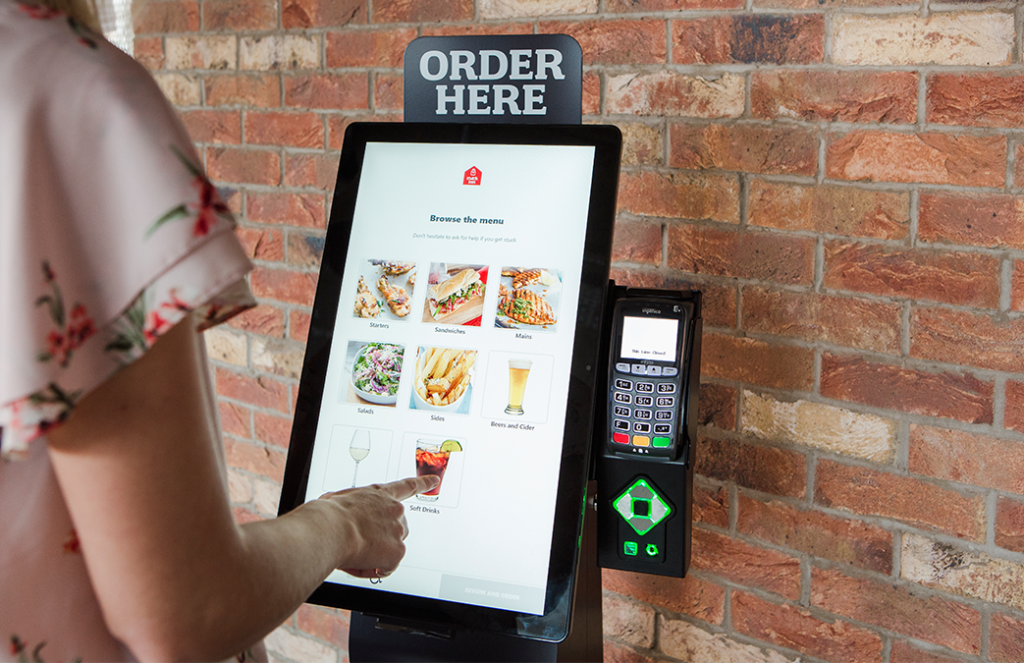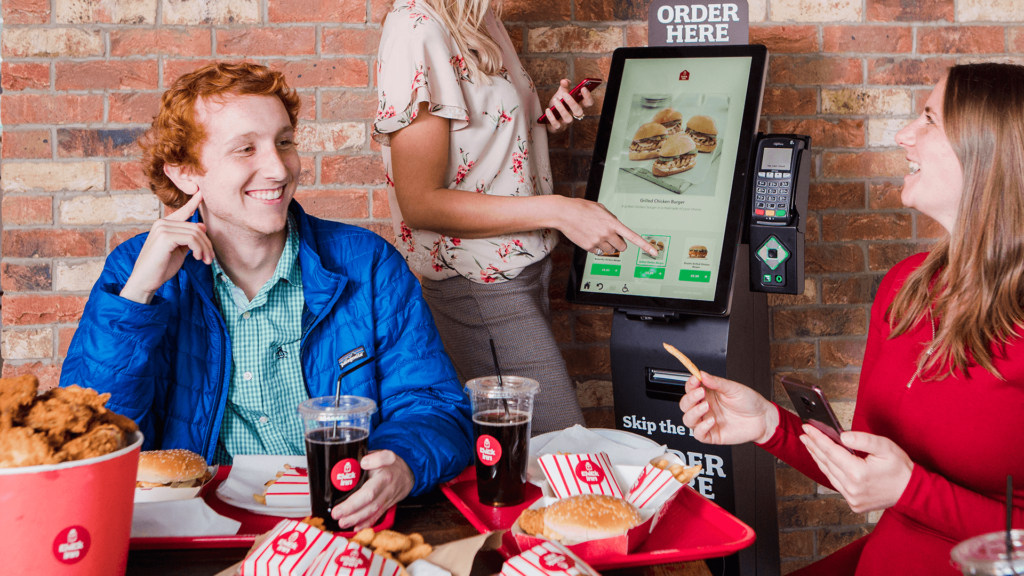[vc_row][vc_column][vc_column_text]Kiosks are taking the quick-service restaurant industry by storm. From McDonald’s to Taco Bell, to Shake Shack, there’s hardly a fast food joint in town that isn’t jumping on the self-ordering bandwagon. And for good reason. Kiosks are proven to drive sales, reduce overheads, increase loyalty and streamline operations in the front and back of house. With clever menu design and strategically placed upsells and cross-sells they typically increase a store’s average transaction value by 20%, rising to 50% with best practice.
However, achieving a 50% ATV boost doesn’t happen overnight, even with perfect execution. The numbers tend to build up month-on-month as guests become aware of the new channel and engrain its use into their habits. Indeed, for many brands, the metrics don’t really start moving until 3-6 months in. Leaders in the kiosk ordering industry, McDonald’s and Panera, have taken three and five years respectively to get where they are now, with the former seeing 33% of sales coming through its digital channels as of October 2018. The lag between initial deployment and seeing the big impact on numbers can generally be attributed to the time it takes for a disruptive technology to be adopted by a new consumer-base, and for operators to smooth out any kinks in their process.
Let’s look at the key stages of kiosk adoption in a QSR environment and what operators can do to pump the gas on the journey to ROI.
Stage 1: Awareness
The key to making guests aware of any new technology, and how it works, is by investing in staff training and incentives that will create enthusiasm around the technology and drive adoption. Your front-of-house team are the face of the technology – if you don’t have their buy-in, quite simply, you won’t see the best results.
Make sure to reiterate to staff that kiosks are not about replacing man with machine. In very few instances do kiosks result in a reduction in staff. More commonly the outcome will result in staff reapportion to fulfillment zones as kiosks increase the frequency and size of orders coming through the point of sale (POS). Kiosks should make your staffs’ jobs easier, as they automate the part of the process that requires them to remember orders, input them into the system correctly, and handle money. Their new roles will focus on improving the guest experience – attending to customers that require extra support and ensuring the fulfillment process is streamlined and efficient.
To drive kiosk awareness more widely, operators should task their PR department to create a buzz around their new investment. This could be achieved by engaging media with a press campaign touting the benefits of the kiosks and how they fit into your long-term digital strategy.
Onsite, you can also increase awareness by making sure your kiosks are appropriately placed, in an area where your guests will see them as soon as they come in the store, and not in an area that will block the front desk or collection lines. Use signage, Point of Purchase displays (POP) and engaging attract screens on your kiosks to catch customer’s eyes. By making sure they are visible from the counter, guests waiting in line will be able to watch kiosk users navigate the solution quickly and successfully, increasing the likelihood that they will opt to use them next time they’re in store.
Stage 2: Adoption
Once you’ve appropriately signposted your kiosks, and ensured all front-of-house staff understand how they work, the next stage should involve driving adoption through staff protocols and attractive incentives at the store and employee level.
In the front-of-house, this can be achieved by ensuring there is always a Kiosk Ambassador on shift, whose responsibility it is to direct guests to the kiosks. Ambassadors should be prepared to walk guests through the order process, even inputting the order as the guest dictates it to them. This can be a good way to introduce more cautious guests to the technology and will increase the likelihood that they’ll opt to use it next time they’re in store.
To increase the rate of kiosk adoption, you should also consider introducing an internal incentive program. During the first three months of launch, try offering an “Employee of the Week” cash reward for the staff member who drives the most guests to use the solution, or for the employee that proved most helpful when fielding guests’ questions. At the corporate level, you may want to consider incentivizing managers by allocating a store target for kiosk orders.
Stage 3: Repeated use
It’s important that the effort you put into raising awareness and driving adoption of your kiosks doesn’t drop off a few months post deployment. It’s only through reiteration, reinforcement and continued staff encouragement that you will start to see a sharp increase in adoption rates, and ultimately a fast ROI. Once the technology has been accepted, there should be less need to create a buzz around the investment, and promotion will carry itself organically. However, that doesn’t mean you should close the book on the best practices that you have established.
Stage 4: Iterative improvements
Long term kiosk success hinges on having a process for continuous improvement. It’s unrealistic to think that your very first user interface, for example, will always be the perfect fit. QSR brands experiencing the highest return on investment through kiosk ordering are constantly learning, failing and changing. In 2018, Shake Shack announced it was planning to remove cash from all 162 of its stores in favor of cashless kiosks, only to later roll back its plan after receiving a backlash from guests that wanted to pay with cash. Clearly, this is an area of hospitality technology where everyone is still learning, even industry trailblazers like Shack Shack, a company that first piloted kiosks back in mid-2017.
Operators looking to maximize their kiosk investment should continuously review variables such as in-store kiosk placement, signage, staff training and menu design (popular pairings, colors, fonts, buttons etc.) to discover areas for improvement and new ways to provide solutions to guests’ problems. This can be achieved by working with a software provider that provides access to granular data from the back-end that will allow you to make informed inferences and tighten your solution.
By viewing kiosks as a journey and not a commodity, operators will be in the perfect position to monetize long-term. In a QSR environment, kiosks are revolutionary and unparalleled when it comes to the positive effect they can have on your bottom line. From increasing the average check value and driving throughput, to reducing staff costs through the reapportion of front-of-house staff and uncovering granular data about your customer-base, the benefits of kiosks far outstrip the initial expense.
To achieve a fast kiosk ROI, operators should look to engage staff heavily in the process, and always ensure there is something in it for them. The front-of-house team are the lynchpin to success, particularly in the months post deployment. By bringing everyone on board and embedding digital ordering into your company culture, while adhering to the principles of change management, you will be primed to see incredible results.[/vc_column_text][vc_separator color=”white”][/vc_column][/vc_row][vc_row][vc_column][/vc_column][/vc_row]






